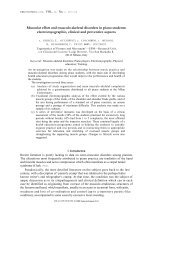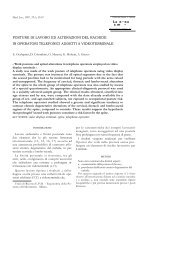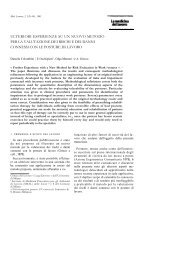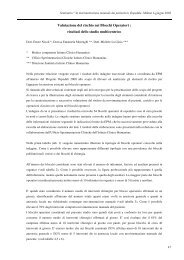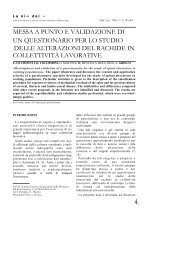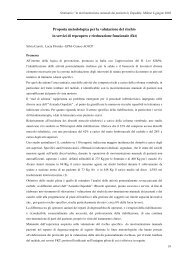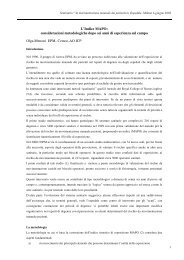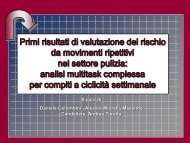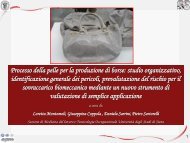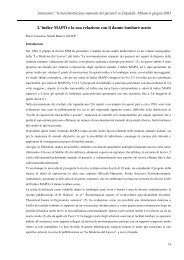Ocra method a new procedure for analysing multiple repetitive tasks
Ocra method: a new procedure for analysing multiple ... - epm
Ocra method: a new procedure for analysing multiple ... - epm
You also want an ePaper? Increase the reach of your titles
YUMPU automatically turns print PDFs into web optimized ePapers that Google loves.
weighted average but redefined on time constants; c) complexmultitask <strong>for</strong>mula <strong>for</strong> OCRA (index and checklist) based onequation (2).a) Calculation of average index weighted by exposure timeIt is the same as above reported when <strong>repetitive</strong> taskrotation occurs at least every hour (equation (1)).As regards this calculation hypothesis, it will tend fromtime to time to under evaluate or over evaluate exposure sinceit is not able to take into due account the monthly exposureduration likely to vary during the year.Be<strong>for</strong>e calculating the weighted average, it will benecessary to evaluate:- duration and distribution of breaks and non <strong>repetitive</strong> <strong>tasks</strong>- the net duration of <strong>repetitive</strong> <strong>tasks</strong> in a typical day of theyear (ea: in the specific case of 380 minutes with thecorresponding duration multiplier that is 0.95)- the OCRA checklist intrinsic values of each task reevaluatedconsidering the actual, above reported, organizationalfactors present in a typical shift.Table 10 shows the whole <strong>procedure</strong> and final valuescalculated using equation (1).Intrinsic OCRA checklist values(duration 8 hours incl. lunch breakand 2 breaks 10 minutes each)INTRINSIC OCRA check list valuesamended <strong>for</strong> actual net duration in shiftand break distributionRG LF RG LFWORKINGTASKS Intrinsic %Table 10 - Example of calculation of weighted average index (data from Table 4)AVERAGE INDEX, WEIGHTED FOR EXPOSURE TIME(calculated with INTRINSIC OCRA checklist values amended<strong>for</strong> actual net duration in shift and breaks distribution)Partial WeightedRG limbPartial weighted LFlimb24.5 11,0 23.3 10,5 A 20,2% 4.2 3.722.5 18,0 21.4 17,1 B 26,2% 5.0 4.315.5 4,0 14.7 3,8 C 11,9% 1.6 1.522.5 23,0 21.4 21,9 D 11,9% 2.3 2.324.5 13,0 23.3 12,4 E 14,3% 3.0 2.418.5 6,0 17.6 5,7 F 9,5% 1.5 1.320.5 16,0 19.5 15,2 G 6,0% 3.1 2.8100% 20,8 12,9b) Calculation of weighted average index on exposureconstantsRecalling the concept of time constants presented in Table5, time proportions re-weighted <strong>for</strong> indicated constants will beused to make the calculation of weighted average. An exampleof final evaluation (data by Table 6) is given in Table 11.Intrinsic OCRA checklist values(duration 8 hours incl lunch breakand 2 breaks 10 minutes each)INTRINSIC OCRA check list valuesamended <strong>for</strong> actual net duration in shiftand break distributionRG LF RG LFWORKINGTASKSAVERAGE INDEX WEIGHTED FOR EXPOSURE CONSTANT(calculated with INTRINSIC OCRA checklist values amended <strong>for</strong>actual net duration in shift and breaks distribution)CONSTANTWEIGHTED %Partial WeightedRG limbPartial weighted LFlimb24.5 11,0 23.3 10,5 A 19,3% 4,5 2,022.5 18,0 21.4 17,1 B 25,0% 5,3 4,315.5 4,0 14.7 3,8 C 11,4% 1,7 0,422.5 23,0 21.4 21,9 D 11,4% 2,4 2,524.5 13,0 23.3 12,4 E 13,6% 3,2 1,718.5 6,0 17.6 5,7 F 9,1% 1,6 0,520.5 16,0 19.5 15,2 G 5,7% 1,1 0,995% 19,8 12,3Table 11 –Example of calculation of the average index weighed over time constants (data by Table 6).The example reported in Table 11 clearly shows that theexposed staff works in the year <strong>for</strong> a time slightly lower thanidentified time constants (5% less). Even the exposureproportions of <strong>tasks</strong> appear to decrease as compared withthose indicated <strong>for</strong> the previous calculation <strong>method</strong>, hence thefinal index is lower than the one obtained calculating theclassical weighted average (Table 10). The opposite wouldoccur <strong>for</strong> exposure times exceeding the constants.c) Calculation of exposure index with the OCRA MultitaskComplex modelThe calculation assumes application of Multitask ComplexModel already presented <strong>for</strong> assessment of daily exposure toseveral <strong>tasks</strong> with rotation exceeding one hour (equation (2)):To be able to calculate Dum i (duration multiplier of eachtask in the year), it was devised to:- reduce the exposure period to a fictitious working shift6



